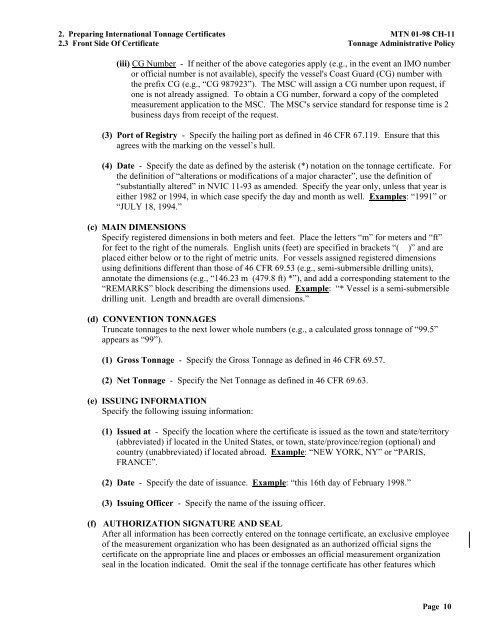Marine Safety Center Technical Note - U.S. Coast Guard
Marine Safety Center Technical Note - U.S. Coast Guard
Marine Safety Center Technical Note - U.S. Coast Guard
You also want an ePaper? Increase the reach of your titles
YUMPU automatically turns print PDFs into web optimized ePapers that Google loves.
2. Preparing International Tonnage Certificates MTN 01-98 CH-11<br />
2.3 Front Side Of Certificate Tonnage Administrative Policy<br />
(iii) CG Number - If neither of the above categories apply (e.g., in the event an IMO number<br />
or official number is not available), specify the vessel's <strong>Coast</strong> <strong>Guard</strong> (CG) number with<br />
the prefix CG (e.g., “CG 987923”). The MSC will assign a CG number upon request, if<br />
one is not already assigned. To obtain a CG number, forward a copy of the completed<br />
measurement application to the MSC. The MSC's service standard for response time is 2<br />
business days from receipt of the request.<br />
(3) Port of Registry - Specify the hailing port as defined in 46 CFR 67.119. Ensure that this<br />
agrees with the marking on the vessel’s hull.<br />
(4) Date - Specify the date as defined by the asterisk (*) notation on the tonnage certificate. For<br />
the definition of “alterations or modifications of a major character”, use the definition of<br />
“substantially altered” in NVIC 11-93 as amended. Specify the year only, unless that year is<br />
either 1982 or 1994, in which case specify the day and month as well. Examples: “1991” or<br />
“JULY 18, 1994.”<br />
(c) MAIN DIMENSIONS<br />
Specify registered dimensions in both meters and feet. Place the letters “m” for meters and “ft”<br />
for feet to the right of the numerals. English units (feet) are specified in brackets “( )” and are<br />
placed either below or to the right of metric units. For vessels assigned registered dimensions<br />
using definitions different than those of 46 CFR 69.53 (e.g., semi-submersible drilling units),<br />
annotate the dimensions (e.g., “146.23 m (479.8 ft) *”), and add a corresponding statement to the<br />
“REMARKS” block describing the dimensions used. Example: “* Vessel is a semi-submersible<br />
drilling unit. Length and breadth are overall dimensions.”<br />
(d) CONVENTION TONNAGES<br />
Truncate tonnages to the next lower whole numbers (e.g., a calculated gross tonnage of “99.5”<br />
appears as “99”).<br />
(1) Gross Tonnage - Specify the Gross Tonnage as defined in 46 CFR 69.57.<br />
(2) Net Tonnage - Specify the Net Tonnage as defined in 46 CFR 69.63.<br />
(e) ISSUING INFORMATION<br />
Specify the following issuing information:<br />
(1) Issued at - Specify the location where the certificate is issued as the town and state/territory<br />
(abbreviated) if located in the United States, or town, state/province/region (optional) and<br />
country (unabbreviated) if located abroad. Example: “NEW YORK, NY” or “PARIS,<br />
FRANCE”.<br />
(2) Date - Specify the date of issuance. Example: “this 16th day of February 1998.”<br />
(3) Issuing Officer - Specify the name of the issuing officer.<br />
(f) AUTHORIZATION SIGNATURE AND SEAL<br />
After all information has been correctly entered on the tonnage certificate, an exclusive employee<br />
of the measurement organization who has been designated as an authorized official signs the<br />
certificate on the appropriate line and places or embosses an official measurement organization<br />
seal in the location indicated. Omit the seal if the tonnage certificate has other features which<br />
Page 10
















